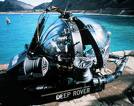|
Deep Rover, a personal Submersible
 Deep Rover, a personal submarine from Deep Ocean Technology, designed by Graham Hawkes built 1984, is a futuristic underwater vehicle equipped with two robotic arms. The acrylic-bubble habitat will take oceanographers to depths of 3,000 feet (900m), where they`ll work at sea-level pressure. The vessel "flies" like an underwater helicopter and its set of manipulators can lift 200 pounds each. Deep Rover, a personal submarine from Deep Ocean Technology, designed by Graham Hawkes built 1984, is a futuristic underwater vehicle equipped with two robotic arms. The acrylic-bubble habitat will take oceanographers to depths of 3,000 feet (900m), where they`ll work at sea-level pressure. The vessel "flies" like an underwater helicopter and its set of manipulators can lift 200 pounds each.
Although she can travel untethered, Deep Rover will be attached to Kevlar rope for safety reasons. This connection will also permit a fiberoptic cable link to the main research vesse. Scientists and crew members on board the support vessel will receive video imagery captured and sent from Deep Rover and remain in constant communication with its pilot.
Technical specifications, Deep Rover:
Two 160 degree, five inch thick (12.7cm) acrylic plastic hemispheres, joined by two aluminum rings to form a single sphere, 64" in (162.5cm) outside diameter.
Weight in air (lb/kg): 11,000/4,600
Payload in air (kg): 90
Dimensions (L*W*H feet/meter): 8`2*6`3*7`8/2.50*1.90*2.30
Propulsion: 4*1hp innerspace thrusters-2*rear thrusters fixed, 2*forward thrusters rotatable, all thrusters can be independently activated,2*battery pods providing 120V
Speed (sub/knots): 2.5
Range (sub n/miles@knots): 5 hours operational time
Diving depth (feet/meter): 3,000/900
Complement: 1 pilot, no researchers
Construction: panoramic, via plastic pressure hull, one scanning sonar, 2*five function manipulators, sensory feedback type, with variable geometry and options.
Back to History Index
 |
Palau |
1995 |
Deep Rover 3,000 feet |
 |
Micronesia |
1997 |
Sylvia Earle, Deep Rover 1970 |
|